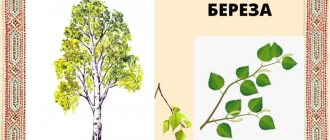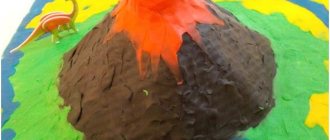Acetic acid and baking soda are inexpensive, accessible products that are widely used in the household.
Photo: Depositphotos.com. Author: ilona75.
They are used in baking confectionery products as a leavening agent or as cleaning agents and detergents that help get rid of scale, grease, lime deposits and stains on clothes.
And with the help of these substances, you can conduct an educational experience for children by making a “real volcano” from soda and vinegar at home.
How the components work and what happens during the experiment
When you combine soda with vinegar, you can observe a lot of foam and hear a characteristic hissing sound. Why is this happening?
This phenomenon is a simple chemical reaction that proceeds quite violently and spectacularly.
Baking soda, or sodium bicarbonate, is an alkali, and when combined with an acid, it breaks down into salt, water and carbon dioxide. In other words, substances are neutralized, due to which abundant foam is released.
On a note. The duration of the reaction depends on the volume of components that are used during the experiment. The more soda, the longer the eruption will be.
Beautiful artificial snow made from soda.
Experiments at home: rain cloud in a jar
As small drops of water accumulate in a cloud, they become heavier and heavier. Eventually they will reach such a weight that they can no longer remain in the air and will begin to fall to the ground - this is how rain appears.
This phenomenon can be shown to children using simple materials.
You will need:
Shaving foam
Food coloring.
1.
Fill the jar with water.
2.
Apply shaving foam on top - it will be a cloud.
3.
Have your child start dripping food coloring onto the “cloud” until it starts to “rain”—drops of coloring begin to fall to the bottom of the jar.
During the experiment, explain this phenomenon to your child.
You will need:
Warm water
Sunflower oil
4 food colors
1.
Fill the jar 3/4 full with warm water.
2.
Take a bowl and stir 3-4 tablespoons of oil and a few drops of food coloring into it. In this example, 1 drop of each of the 4 dyes was used - red, yellow, blue and green.
3.
Using a fork, stir the coloring and oil.
4.
Carefully pour the mixture into a jar of warm water.
5.
Watch what happens - the food coloring will begin to slowly fall through the oil into the water, after which each drop will begin to disperse and mix with the other drops.
* Food coloring dissolves in water, but not in oil, because... The density of oil is less than water (that’s why it “floats” on water). The dye droplet is heavier than the oil, so it will begin to sink until it reaches the water, where it will begin to disperse and look like a small fireworks display.
Conducting an experiment: 3 simple ways
By showing imagination and creativity, you can come up with various options for conducting this experiment.
Let's start with the simplest thing.
Method 1: “Storm in a teacup”
To conduct the experiment, you will need a glass of water, a tablespoon of vinegar and the same amount of soda.
You need to act in the following sequence:
- Place the vessel on a tray or large plate.
- Pour acetic acid into the water and stir.
- Add soda to the container. You can pour out the entire volume of the substance at once, but the reaction will last longer if you introduce it gradually.
As a result of the contact of the molecules of the substances used, sodium bicarbonate will begin to release carbon dioxide, due to which bubbling occurs.
Method 2: “Awakened Volcano”
To make the picture of the seething volcano more reliable, in addition to the main components, you will need an elongated plastic container, for example, a piece of a 0.5 liter bottle, a baby food jar or a soap bubble cone. You also need plasticine for decoration.
You need to act in this order:
- Cover a plastic container with plasticine, imitating the mouth of a volcano.
- Place the workpiece on a tray and fill it with soda to about halfway.
- Add a few tablespoons of vinegar.
Advice. You can make “volcanic lava” colored by mixing soda with dye. Then the spectacle will be truly amazing and will delight little spectators.
Method 3: "Rainbow Lava"
Children prefer colored and colorful spectacles, and you can make several volcanoes from soda and citric acid, adding different dyes.
Preparing the experiment will take a little longer than in previous cases, but the effect is worth it.
To organize the experiment you will need:
- 6 small cups or baby food containers;
- gouache paints of different shades;
- soda;
- lemon acid;
- water.
Advice. To protect the surface of the table, it is better to choose a tray or other stand with high sides, since the eruption will be violent and abundant.
You will need to do the following:
- Roll 6 colorful balls of sodium bicarbonate and gouache and set them aside.
- Place jars on a tray at some distance from each other and fill them with water.
- Dissolve citric acid in vessels. If you don’t have it in the house, you can pour vinegar.
- Throw one ball into each jar and observe the multi-colored reaction.
Thanks to this experiment, children will be able not only to watch the rainbow eruption, but also, after the reaction is completed, to look for a long time at the bizarre mixture of colors on the tray.
Did you know? Sodium bicarbonate in combination with vinegar will help inflate balloons without difficulty. To do this, you will need to pour acetic acid diluted with water in a 1:1 ratio into the bottle, and fill the ball with soda.
Then you need to put it on the neck of the vessel, secure it with tape or a rubber band (otherwise it will fall off) and lift it so that the bulk composition gets into the liquid.
When the components interact, a violent reaction will begin, as a result of which carbon dioxide will be released, which will fill the ball.
Reusable craft
This option is very convenient, because you can return to the created volcano again and again. To create a craft you will need:
- Paper;
- Plastic lid for mayonnaise or sour cream;
- Foil;
- Gypsum plaster;
- Regular tape and masking tape;
- Acrylic paint;
- Basis for the product;
- Regular 1.5 liter bottle.
Next we follow the instructions. We do the following step by step:
- Cut the top of the plastic bottle so that you have a mountain of a suitable height, place it in the lid and secure it with tape. The result was a strong foundation for the volcano.
- Attach the resulting craft to the plywood with tape. You can also use a plastic backing as a base.
- Then you need to give the bottle a cone shape. Take some foil and wrap it around the bottle and secure it with masking tape. We take the paper, tear it into small pieces and secure them with masking tape around the product.
- Dilute the gypsum plaster with water to a thick consistency and pour it onto the product. Correct the necessary places.
- Wait two to three hours, let the product dry thoroughly, then decorate it to your liking.
For the eruption you will need: vinegar, a little baking soda, red food coloring, a little dishwashing detergent.
Now the most interesting stage has come. Place a little baking soda inside the crater, add a little dishwashing liquid and add red food coloring. If required, add a little water. Add a little vinegar to the crater of the volcano, and the eruption begins!
Precautions when working with chemicals
Important! Any substance, even the most harmless at first glance, can be dangerous if handled incorrectly. The components for the experiments listed are no exception.
To ensure that the “volcano splashing with hissing lava” brings only joy and the fun does not end in trouble, the following precautions must be observed:
- The experiment should only be carried out under adult supervision. Children should not be allowed to experiment with chemicals on their own.
- Before starting the experiment, you should stock up on kitchen towels in order to clean up in time if a caustic liquid spills.
- When working with acid, it is important to prevent it from coming into contact with exposed skin to avoid burns, and if this happens, immediately wash off the liquid with water. You can protect your hands with rubber gloves.
- When there is a “volcanic eruption,” you should not come close to it or lean over the vessels in order to better see what is happening. During boiling, caustic splashes can get on the skin or mucous membrane of the eyes.
- After completing the experiment, you should not leave the used materials; you should immediately drain the remaining liquid into the sink, wash the dishes and put the chemicals out of the reach of children.
Small tips
When creating woodcan at home, use your imagination. Here are some tips:
- If desired, color the product.
- Add the ingredients carefully to avoid messing anything up.
- To enhance the eruption, add mints and soda.
- Be sure to wear goggles and gloves.
As you can see, making a volcano at home is simple and fun. The product will give an unforgettable experience to both children and adults. Making a volcano can be combined with a geography or chemistry lesson for children, and adults will simply have a good time doing this activity.
Originally posted 2018-08-29 09:26:24.
What's inside the Earth?
In order to understand the nature of volcanoes, you need to know the structure of the Earth.
The earth consists of the following layers:
- The earth's crust is the upper layer of the Earth in which living organisms can exist. The thickness of the earth's crust can be from 40 to 70 km;
- the mantle is the solid layer that lies below the earth's crust. Its temperature is quite high, but the substance is in a solid state. The thickness of the mantle is about 3,000 km;
- core - the central part of the globe. Its radius is approximately 3,500 km. The temperature inside the core is very high. — A core heated to 4,000 – 5,000 degrees Celsius. The core is believed to consist mainly of molten metal, presumably iron.
A volcano is a mountain with a very deep hole at its top (crater)
Types of volcanoes
Shield: almost flat - since they are formed by flows of poorly solidified liquid - lava, spreading over thousands of kilometers.
Stratovolcanoes : shaped like a cone, their slopes become steeper with height. They are formed by layers and deposits of hardened lava.
Underwater : formed at the bottom of the sea; under the influence of water they do not explode, but spread along the ocean floor. Exceptions are volcanoes located at shallow depths, in which case a new island can form from the emissions.
Cone-shaped : flat, steep slopes and a wide cupped crater. Rarely above 300 meters.
Mud volcanoes.
Why are volcanic eruptions dangerous or beneficial?
In ancient times, people did not know how to explain the causes of volcanic eruptions, so this formidable natural phenomenon plunged people into horror.
For example, the 1883 Krakatoa eruption ejected about 21 square kilometers of rock, ash and pumice. The eruption destroyed two-thirds of the island of Krakatoa. The air temperature has dropped significantly. Weather conditions continued to be unstable for several years, and temperatures returned to normal only after 5 years.
Volcanic activity is not always harmful.
Volcanic dust is used to make medicines, fertilizers, and water purifiers. Houses are built from hardened lava. Volcanoes also supply us with carbon, nitrogen and other gases from the bowels of the earth, without which life on Earth is impossible. In Iceland, the heat generated by underground magma is used to generate electricity and heat greenhouses where food is grown.
The soils formed during the weathering of lava are very rich in minerals and, when cultivated, are extremely fertile.
There are no volcanoes in our region. But we can find products of volcanic origin. This is the pumice stone that we use in everyday life.





